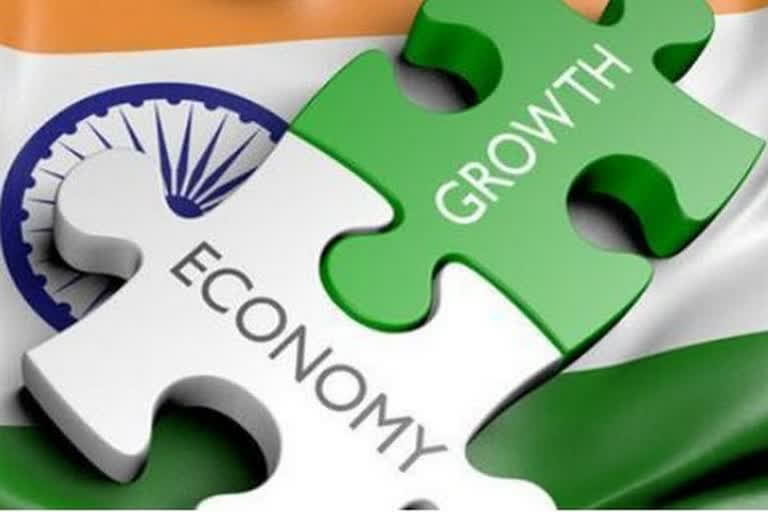New Delhi: India’s economy is unlikely to witness double-digit growth in the current financial year as the novel coronavirus has been mutating fast and the governments at various levels perceive lockdowns and other restrictions on economic activities as the best possible option to curtail the next wave of Covid-19 infections amid the slow vaccine coverage. According to reports by various rating agencies as well as the estimates of the Reserve Bank of India (RBI), the growth in Gross Domestic Product (GDP) will be nearly 9.5 per cent against earlier estimates in the range of 10.5-13.7 per cent due to the damage caused by the second Covid-19 wave and the impending waves.
For instance, Moody’s Investors Service, in its latest estimates, slashed India's growth forecast for FY 2021-22 to 9.3 per cent saying that the second wave of coronavirus infections hampers economic recovery and increases the risk of longer-term scarring. "The surge of the virus, which has been driven by a highly contagious variant, has put significant strain on India's healthcare system with hospitals overrun and medical supplies in short supply," the US-based rating agency said. Before the emergence of Covid-19, last February, it had forecast a 13.7 per cent economic growth for the current fiscal (April 2021-March 2022).
Echoing these views, Barclays, a British brokerage, had cut India's FY22 GDP growth estimate by a sharp 0.80 per cent to 9.2 per cent, saying the economic impact of the second wave of infections has been deeper than initially expected. "Although India's second COVID-19 wave has started to recede, the related economic costs have been larger owing to the more stringent lockdowns implemented to contain the outbreak… we lower our FY 2021-22 GDP growth forecast a further 0.80 per cent, to 9.2 per cent,” Barclays said. Barclays further estimated that Covid-19-induced restrictions will result in economic losses to the tune of Rs 5.48 lakh crore in the April-June period alone.
"While we continue to believe the lockdowns will last only until the end of June 2021, in our new base case, we now estimate economic losses of USD 74 billion (about Rs 5.48 lakh crore), all of it contained in Q2 21 (April-June)," the brokerage said. Similarly, the RBI lowered the country's growth forecast for the current financial year by a percentage point to 9.5 per cent in view of the uncertainties created by the Covid-19 second wave."Real GDP growth is now projected at 9.5 per cent in 2021-22 consisting of 18.5 per cent in April-June; 7.9 per cent in July-September; 7.2 per cent in October-December; and 6.6 per cent in January-March of 2021-22," the RBI Governor Shaktikanta Das said while announcing the latest monetary policy earlier this month.
In simple terms, GDP is the country's overall economic output and it is a major indicator of the health of the economy. In FY 2020-21, India's GDP witnessed a de-growth of 7.3 per cent, the worst performance since independence.
Coronavirus mutations take Covid-19 tally to 3 crore
India's total tally of COVID-19 cases crossed the three crore mark on Wednesday while the death toll climbed to over 3.9 lakh. An analysis of the Union Health Ministry data shows that India's total COVID-19 infections had surpassed the one crore mark on December 19 after which it took around 136 days to cross the two crore mark on May 4 and the latest one crore cases surfaced only in 50 days. According to experts, the rapid spread of the virus is primarily attributed to its mutations.
"The two main causes (for the rise in infections) are-when in Jan/Feb vaccination started and cases went down people stopped following COVID appropriate behaviour and at this time the virus mutated and it spread more rapidly," All India Institute of Medical Sciences (AIIMS) Director Dr Randeep Guleria told news agency ANI earlier this year.
One crore doses per day – The need of the hour
The Union Health Ministry on Tuesday categorised the Delta Plus variant of the coronavirus as a ‘variant of concern’. Notably, the Delta Plus is closely related to the Delta variant which is primarily responsible for the second wave of Covid-19 in the country. Amid concerns about the impending third wave of the virus, rating agencies observed that faster vaccination progress will be paramount in restricting economic losses to the current quarter (April-June period).
"Mobility and economic activity will likely to accelerate in the second half of the year as the pace of vaccinations pick up. The government recently announced a strategy to centralise vaccine procurement in order to boost vaccinations, which if successful, will support the economic recovery," Moody’s said in its report on Wednesday. Similarly, a research report by the SBI observed that a stronger economic recovery is possible if the vaccine administration reaches 1 crore doses per day.
“There are concerns around whether the economy will reach the pre-pandemic levels in FY22…GDP growth of 7.9 per cent is possible if the country indeed delivers on the stated aim of 1 crore vaccines a day by mid-July,” the SBI research said early this month. According to the government data, India’s cumulative COVID Vaccination Coverage crossed the 30 crore mark on Wednesday and the average daily coverage has crossed the 50 lakh mark since the launch of the new phase of vaccination on June 21 against the previous average of 25-30 lakh doses per day.


